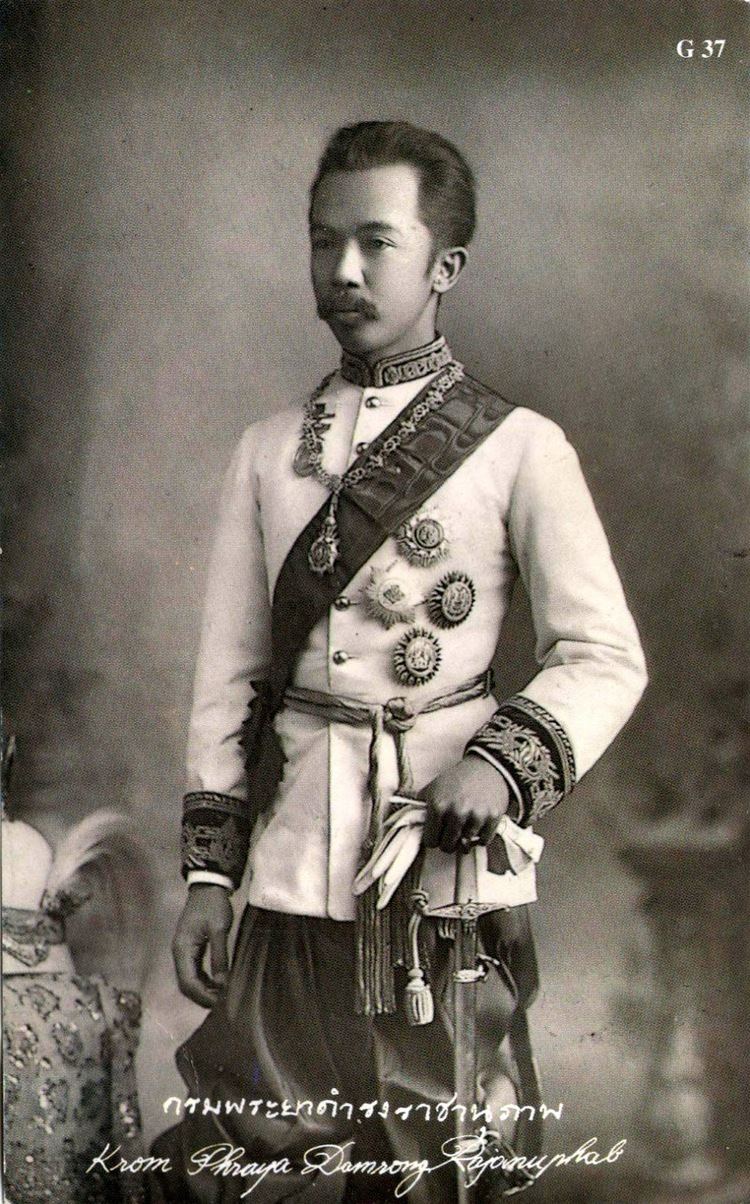House House of Chakri Name Damrong Rajanubhab Parents Mongkut | Mother Consort Chum Signature Siblings Chulalongkorn | |
 | ||
Books The Chronicle of Our Wars with the Burmese: Hostilities Between Siamese and Burmese when Ayutthaya was the Capital of Siam Similar People | ||
Children Subhadradis Diskul (M.C.) | ||
Prince Tisavarakumarn, the Prince Damrong Rajanubhab (สมเด็จพระเจ้าบรมวงศ์เธอ พระองค์เจ้าดิศวรกุมาร กรมพระยาดำรงราชานุภาพ; rtgs: Ditsawarakuman Damrongrachanuphap) (21 June 1862 – 1 December 1943) was the founder of the modern Thai educational system as well as the modern provincial administration. He was an autodidact, a (self-taught) historian, and one of the most influential Thai intellectuals of his time.
Contents

Born as Phra Ong Chao Tisavarakumarn (พระองค์เจ้าดิศวรกุมาร; "Prince Tisavarakumarn"), a son of King Mongkut with Consort Chum (เจ้าจอมมารดาชุ่ม; Chao Chom Manda Chum), a lesser royal wife; he initially learned Thai and Pali from private tutors, and English at the Royal School with Mr Francis George Patterson. At the age of 14, he received his formal education in a special palace school created by his half-brother, King Chulalongkorn. He was given posts in the royal administration at an early age, becoming the commander of the Royal Guards Regiment in 1880 at age 18, and after several years he worked at building army schools as well as modernizing the army in general. In 1887, he was appointed as grand-officer to the army (commander-in-chief). At the same time he was chosen by the king to become the Minister of Education in his provisional cabinet. When King Chulalongkorn began his administrative reform programme in 1892, Prince Damrong was chosen to lead the Ministry of the North (Mahatthai), which was converted into the Ministry of the Interior in 1894.
In his time as minister, he completely overhauled provincial administration. Many minor provinces were merged into larger ones, the provincial governors lost most of their autonomy when the post was converted into one appointed and salaried by the ministry, and a new administrative division—the monthon (circle) covering several provinces—was created. Formal education of administrative staff was introduced. Prince Damrong was among the most important advisors of the king, and considered second only to him in power.
Political climate in Siam (1855–1893)
For further information, see: Gustave Rolin-Jaequemyns #Situation in SiamLegal traditions made little if any sense to foreigners. Nor did they have knowledge of the ancient political climate. Nor aware that the Bowring Treaty, which nearly all considered a significant advancement, had accomplished none of its objectives and had been set-back for the Siamese for the ensuing decades. Monthon reforms met with resistance, complicated by French interference in Siamese authority.
Foreign advisers
Prince Damrong went to Europe in search of a European general advisor for the king by way of the Suez Canal. In December 1891, during a lunch hosted by the British ambassador to Egypt, Damrong met Gustave Rolin-Jaequemyns, who had edited the first issue of Revue de Droit International et de Législation Comparée ("Review of International Law and Comparative Legislation"), which had appeared late-1868 with contributions from many noted scholars. Following a hasty correspondence with Bangkok, the prince was able to offer Rolin-Jaequemyns an annual salary of ₤3,000. Among his successors were Edward Strobel, the first American adviser in foreign affairs, followed with lesser titles by Jens Westengard, Eldon James, and Francis B. Sayre. Strobel, Westengard, James, and Sayre were all Harvard law professors.
Later years
After the death of King Chulalongkorn in 1910, the relationship with his successor King Vajiravudh was less productive. Prince Damrong finally resigned in 1915 from his post at the ministry, officially due to health problems, since otherwise the resignation would have looked like an affront to the monarch.
During the brief reign of King Prajadhipok, the prince proposed that the king found the Royal Institute, mainly to look after the National Library and the museums. He became the first president of the Royal Institute of Thailand. He was given the title Somdet Phra Chao Borommawong Thoe Krom Phraya Damrong Rajanubhab by King Prajadhipok in recognition to his work. This became the name by which he is generally known.
In the following years, Damrong worked as a self-educated historian, as well as writing books on Thai literature, culture and arts. Out of his works grew the National Library, as well as the National Museum.
Being one of the main apologists for absolute monarchy, after the Siamese revolution of 1932 which introduced Constitutional monarchy in the kingdom, Damrong was exiled to Penang in British Malaysia. In 1942, after the old establishment had substantially regained power from the 1932 reformists, he was allowed to return to Bangkok, where he died one year later.
Prince Damrong is credited as the father of Thai history, the education system, the health system (the Ministry of Health was originally a department of the Ministry of the Interior) and the provincial administration. He also had a major role in crafting Bangkok's anti-democratic state ideology of "Thainess".
On the 1962 centenary of his birth, he became the first Thai to be included in the UNESCO list of the world's most distinguished persons. On 28 November 2001, to honour the contributions the prince made to the country, the government declared that 1 December would thereafter be known as "Damrong Rajanupab Day".
His many descendants use the royal surname Tisakula (Thai: ดิศกุล.)
Writings
Prince Damrong wrote countless books and articles, of which only a few are available in English translation:
